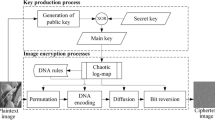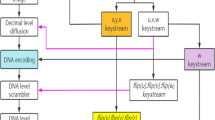Abstract
Recently, a reversible data hiding (RDH) scheme based on code division multiplexing (CDM) has been reported, in which secret information and pseudo bits are transformed into spreading sequences. Most sequences may be mutually offset when they are repeatedly embedded, which leads to image quality and embedding capacity improvement. Despite of these advantages, the pseudo bits may cause the image distortion, especially in the low embedding rates. Moreover, it is hard to protect image content when the image is uploaded to cloud server. In order to solve these problems, we propose an RDH scheme based on CDM in multiple encrypted images (RDHMEI) with public key cryptography. The proposed method first encrypted the image using the Paillier homomorphic encryption. Afterwards, the encrypted pixels that have a same coordinate in the multiple images are selected as the elements of the embedding vector. Instead of traditional dual-images based RDH, the proposed method can embed additional bits into the embedding vector while the pixel correlation disappears after encrypting. Experimental results demonstrate the effectiveness and advantages of the proposed method.




Similar content being viewed by others
References
Chang CC, Kieu TD, Chou YC (2007) Reversible data hiding scheme using two steganographic images. In: IEEE Region 10 Conference, TENCON 2007, pp 1–4
Chang CC, Pai PY, Yeh CM (2010) A high payload frequency—based reversible image hiding method. Inf Sci 180(11):2286–2298
Chen XY, Sun XM, Sun HY, Zhou ZL, Zhang JJ (2013) Reversible watermarking method based on asymmetric-histogram shifting of prediction errors. J Syst Softw 86(10):2620–2626
Chen YC, Shiu CW, Horng G (2014) Encrypted signal-based reversible data hiding with public key cryptosystem. J Vis Commun Image Represent 25(5):1164–1170
Fu Z, Wu X, Wang Q, Ren K (2017) Enabling central keyword-based semantic extension search over encrypted outsourced data. IEEE Trans Inf Forensics Secur 12(12):2986–2997
Fu Z, Huang F, Ren K, Weng J, Wang C (2017) Privacy-preserving smart semantic search based on conceptual graphs over encrypted outsourced data. IEEE Trans Inf Forensics Secur 12(8):1874–1884
Fujiyoshi M, Sato S, Jin HL, Kiya H (2007) A location-map free reversible data hiding method using block-based single parameter. In: IEEE International Conference on Image Processing, ICIP 2007, 3: pp III–257
Hong W, Chen T, Wu H (2012) An improved reversible data hiding in encrypted images using side match. IEEE Signal Process Lett 19(4):199–202
Jafar IF, Darabkh KA, Al-Zubi RT, Saifan RR (2016) An efficient reversible data hiding algorithm using two steganographic images. Signal Process 128(11):98–109
Lee CF, Chen HL, Tso HK (2010) Embedding capacity raising in reversible data hiding based on prediction of difference expansion. J Syst Softw 83(10):1864–1872
Li M, Xiao D, Zhang Y, Nan H (2015) Reversible data hiding in encrypted images using cross division and additive homomorphism. Signal Process Image Commun 39(PA):234–248
Liao X, Shu C (2015) Reversible data hiding in encrypted images based on absolute mean difference of multiple neighboring pixels. J Vis Commun Image Represent 28(3):21–27
Liu YL, Qu XX, Xin GJ (2016) A ROI-based reversible data hiding scheme in encrypted medical images. J Vis Commun Image Represent 39(5):51–57
Ma B, Shi YQ (2016) A reversible data hiding scheme based on code division multiplexing. IEEE Trans Inf Forensics Secur 11(9):1914–1927
Ma K, Zhang W, Zhao X, Yu N, Li F (2013) Reversible data hiding in encrypted images by reserving room before encryption. IEEE Trans Inf Forensics Secur 8(3):553–562
Ni Z, Shi YQ, Ansari N, Su W (2006) Reversible data hiding. IEEE Trans Circuits Syst Video Technol 16(3):354–362
Ou B, Li X, Zhao Y, Ni R, Shi YQ (2013) Pairwise prediction error expansion for efficient reversible data hiding. IEEE Trans Image Process 22(12):5010–5021
Paillier P (1999) Public-key cryptosystems based on composite degree residuosity classes. In: International Conference on the Theory and Applications of Cryptographic Techniques. Springer, Berlin, Heidelberg, pp 223–238
Qu Z, Keeney J, Robitzsch S, Zaman F, Wang X (2016) Multilevel pattern mining architecture for automatic network monitoring in heterogeneous wireless communication networks. Chin Commun 13(7):108–116
Ren Y, Shen J, Liu D, Wang J, Kim J (2016) Evidential quality preserving of electronic record in cloud storage. J Internet Technol 17(6):1125–1132
Sachnev V, Kim HJ, Nam J, Suresh S, Shi YQ (2009) Reversible watermarking algorithm using sorting and prediction. IEEE Trans Circuits Syst Video Technol 19(7):989–999
Shiu CW, Chen YC, Hong W (2015) Encrypted image-based reversible data hiding with public key cryptography from difference expansion. Signal Process Image Commun 39(PA):226–233
Tian J (2003) Reversible data embedding using a difference expansion. IEEE Trans Circuits Syst Video Technol 13(8):890–896
Tsai PY, Hu YC, Yeh HL (2009) Reversible image hiding scheme using predictive coding and histogram shifting. Signal Process 89(6):1129–1143
Wang B, Gu X, Ma L, Yan S (2017) Temperature error correction based on BP neural network in meteorological WSN. Int J Sensor Netw 23(4):265–278
Wu XT, Chen B, Weng J (2016) Reversible data hiding for encrypted signals by homomorphic encryption and signal energy transfer. J Vis Commun Image Represent 41(6):58–64
Xia Z, Wang X, Zhang L, Qin Z, Sun X, Ren K (2016) A privacy-preserving and copy-deterrence content-based image retrieval scheme in cloud computing. IEEE Trans Inf Forensics Secur 11(11):2594–2608
Xuan G, Tong X, Teng J, Zhang X, Shi YQ (2013) Optimal histogram pair and prediction-error based image reversible data hiding. In: The International Workshop on Digital Forensics and Watermarking. Springer, Berlin, Heidelberg, pp 368–383
Yang B, Sun S, Schmucker M, Funk W, Busch C (2004) Integer DCT-based reversible watermarking for images using companding technique. Proc SPIE 5306:405–410
Zhang X (2011) Reversible data hiding in encrypted images. IEEE Signal Process Lett 18(4):255–258
Zhang X (2012) Separable reversible data hiding in encrypted image. IEEE Trans Inf Forensics Secur 7(2):526–532
Zhang X, Wang J, Cheng H (2016) Lossless and reversible data hiding in encrypted images with public key cryptograph. IEEE Trans Circuits Syst Video Technol 26(9):1622–1631
Zhang J, Tang J, Wang T, Chen F (2017) Energy-efficient data-gathering rendezvous algorithms with mobile sinks for wireless sensor networks. Int J Sensor Netw 23(4):248–257
Zhou J, Sun W, Dong L, Liu X, Au OC, Tang YY (2016) Secure reversible image data hiding over encrypted domain via key modulation. IEEE Trans Circ Syst Video Technol 26(3):441–452
Acknowledgments
This work is supported by the National Natural Science Foundation of China under grant 61502242, U1536206, U1405254, 61772283, 61602253, 61672294; by the National Key R&D Program of China under grant 2018YFB1003205; by the Jiangsu Basic Research Programs-Natural Science Foundation under grant numbers BK20150925 and BK20151530; by the Priority Academic Program Development of Jiangsu Higher Education Institutions (PAPD) fund; by the Collaborative Innovation Center of Atmospheric Environment and Equipment Technology (CICAEET) fund, China.
Author information
Authors and Affiliations
Corresponding author
Additional information
Publisher’s Note
Springer Nature remains neutral with regard to jurisdictional claims in published maps and institutional affiliations.
Rights and permissions
About this article
Cite this article
Chen, X., Zhong, H. & Qiu, A. Reversible data hiding scheme in multiple encrypted images based on code division multiplexing. Multimed Tools Appl 78, 7499–7516 (2019). https://doi.org/10.1007/s11042-018-6446-y
Received:
Revised:
Accepted:
Published:
Issue Date:
DOI: https://doi.org/10.1007/s11042-018-6446-y




